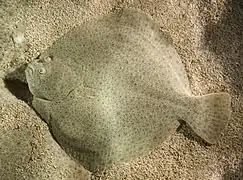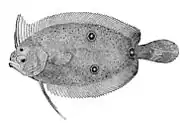Turbot
The turbot (Scophthalmus maximus) is a relatively large species of flatfish in the family Scophthalmidae. It is a demersal fish native to marine or brackish waters of the Northeast Atlantic, Baltic Sea and the Mediterranean Sea. It is an important food fish.[2] Turbot in the Black Sea have often been included in this species, but are now generally regarded as separate, the Black Sea turbot or kalkan (S. maeoticus).[3] True turbot are not found in the Northwest Atlantic; the "turbot" of that region, which was involved in the so-called "Turbot War" between Canada and Spain, is the Greenland halibut or Greenland turbot (Reinhardtius hippoglossoides).[4]
| Turbot | |
|---|---|
 | |
| Scientific classification | |
| Kingdom: | Animalia |
| Phylum: | Chordata |
| Class: | Actinopterygii |
| Order: | Pleuronectiformes |
| Family: | Scophthalmidae |
| Genus: | Scophthalmus |
| Species: | S. maximus |
| Binomial name | |
| Scophthalmus maximus | |
| Synonyms | |
|
List
| |
Etymology
The word comes from the Old French tourbout, which in turn is thought to be a derivative of the Latin turbo ('spinning top') a possible reference to its shape.[5] Another possible origin of the Old French word is from Old Swedish törnbut, from törn 'thorn' + -but 'stump, butt, flatfish', which may also be a reference to its shape (compare native English halibut).[6] Early reference to the turbot can be found in a satirical poem (The Emperor's Fish) by Juvenal, a Roman poet of the late 1st and early 2nd centuries CE, suggesting this fish was a delicacy in the Roman empire.
In English, turbot is pronounced /ˈtɜːrbət/ TUR-bət.[7] The French pronunciation of "turbot" is [tyʁbo].
Description
The turbot is a large left eyed flatfish found primarily close to shore in sandy shallow waters throughout the Mediterranean, the Baltic Sea, the Black Sea and the North Atlantic. The European turbot has an asymmetrical disk-shaped body, and has been known to grow up to 1 metre (39 inches) long and 55 pounds (25 kilograms) in weight.[2][8]
Fisheries
Turbot is highly prized as a food fish for its delicate flavour, and is also known as brat, breet, britt or butt. It is a valuable commercial species, acquired through aquaculture and trawling. Turbot are farmed in Bulgaria, Canada, France, Spain, Portugal, Romania, Turkey, Chile, Norway, and China.[9] Turbot has a bright white flesh that retains this appearance when cooked. Like all flatfish, turbot yields four fillets with meatier topside portions that may be baked, poached, steamed, or pan-fried.
References
- Golani, D.; Kada, O.; Nouar, A.; Quignard, J.P. & Cuttelod, A. (2011). "Scophthalmus maximus". IUCN Red List of Threatened Species. 2011: e.T198731A9089507. Downloaded on 27 March 2018.
- Froese, Rainer and Pauly, Daniel, eds. (2019). "Psetta maxima" in FishBase. December 2019 version.
- Froese, Rainer and Pauly, Daniel, eds. (2019). Species of Scophthalmus in FishBase. December 2019 version.
- Stephens, T. (2009). International Courts and Environmental Protection. Cambridge University Press. pp. 212–214. ISBN 978-0-521-88122-7.
- Oxford English Dictionary, Turbot
- "turbot". Online Etymology Dictionary.
- "turbot", dictionary.reference.com
- Chisholm, Hugh, ed. (1911). . Encyclopædia Britannica. 27 (11th ed.). Cambridge University Press.
- Psetta Maxima Archived 2011-02-23 at the Wayback Machine Seafood Portal
External links
| Look up turbot in Wiktionary, the free dictionary. |
 Media related to Scophthalmus maximus at Wikimedia Commons
Media related to Scophthalmus maximus at Wikimedia Commons- "Scophthalmus maximus (Linnaeus, 1758)". Integrated Taxonomic Information System.





.png.webp)
